Modeling the Effects of Climate Change on Surface Ozone during Summer in the Yangtze River Delta Region, China
Abstract
:1. Introduction
2. Methodology
2.1. Model Description and Configuration
2.2. Simulation Cases
2.3. Present and Future Climate Data
2.4. Anthropogenic Emissions
2.5. Process Analysis Method
2.6. Model Performance Evaluation
3. Results and Discussions
3.1. Model Evaluation for WRF-Chem
3.2. Regional Meteorology Changes
3.3. Changes in Ozone Precursors
3.4. Changes in Ozone Driven by Climate Change
3.5. Impact of Climate Change on Regional Ozone Control Policy
4. Conclusions
Author Contributions
Funding
Conflicts of Interest
References
- Jacob, D.J.; Winner, D.A. Effect of climate change on air quality. Atmos. Environ. 2009, 43, 51–63. [Google Scholar] [CrossRef]
- Athanassiadou, M.; Baker, J.; Carruthers, D.; Collins, W.; Girnary, S.; Hassell, D.; Hort, M.; Johnson, C.; Johnson, K.; Jones, R.; et al. An assessment of the impact of climate change on air quality at two UK sites. Atmos. Environ. 2010, 44, 1877–1886. [Google Scholar] [CrossRef]
- Hassan, N.A.; Hashim, Z.; Hashim, J.H. Impact of Climate Change on Air Quality and Public Health in Urban Areas. Asia-Pac. J. Public Health 2016, 28, 38s–48s. [Google Scholar] [CrossRef]
- Von Schneidemesser, E.; Monks, P.S.; Allan, J.; Bruhwiler, L.; Forster, P.; Fowler, D.; Lauer, A.; Morgan, W.T.; Paasonen, P.; Righi, M.; et al. Chemistry and the Linkages between Air Quality and Climate Change. Chem. Rev. 2015, 115, 3856–3897. [Google Scholar] [CrossRef] [PubMed]
- Paeth, H.; Feichter, J. Greenhouse-gas versus aerosol forcing and African climate response. Clim. Dyn. 2006, 26, 35–54. [Google Scholar] [CrossRef]
- Kodros, J.K.; Scott, C.E.; Farina, S.C.; Lee, Y.H.; L’Orange, C.; Volckens, J.; Pierce, J.; L’orange, C. Uncertainties in global aerosols and climate effects due to biofuel emissions. Atmos. Chem. Phys. Discuss. 2015, 15, 8577–8596. [Google Scholar] [CrossRef]
- Liu, Q.; Lam, K.; Jiang, F.; Wang, T.; Xie, M.; Zhuang, B.; Jiang, X. A numerical study of the impact of climate and emission changes on surface ozone over South China in autumn time in 2000–2050. Atmos. Environ. 2013, 76, 227–237. [Google Scholar] [CrossRef]
- Xie, M.; Shu, L.; Wang, T.-J.; Liu, Q.; Gao, D.; Li, S.; Zhuang, B.-L.; Han, Y.; Li, M.-M.; Chen, P.-L. Natural emissions under future climate condition and their effects on surface ozone in the Yangtze River Delta region, China. Atmos. Environ. 2017, 150, 162–180. [Google Scholar] [CrossRef]
- Wittig, V.E.; Ainsworth, E.A.; Long, S.P. To what extent do current and projected increases in surface ozone affect photosynthesis and stomatal conductance of trees? A meta-analytic review of the last 3 decades of experiments. Plant Cell 2007, 30, 1150–1162. [Google Scholar] [CrossRef] [PubMed]
- Ainsworth, E.A.; Yendrek, C.R.; Sitch, S.; Collins, W.J.; Emberson, L.D. The Effects of Tropospheric Ozone on Net Primary Productivity and Implications for Climate Change. Annu. Rev. Plant Biol. 2012, 63, 637–661. [Google Scholar] [CrossRef]
- Sanchez-Ccoyllo, O.R.; Ynoue, R.Y.; Martins, L.D.; Andrade, M.D. Impacts of ozone precursor limitation and meteorological variables on ozone concentration in Sao Paulo, Brazil. Atmos. Environ. 2006, 40, S552–S562. [Google Scholar] [CrossRef]
- Stathopoulou, E.; Mihalakakou, G.; Santamouris, M.; Bagiorgas, H.S. On the impact of temperature on tropospheric ozone concentration levels in urban environments. J. Earth Sci. 2008, 117, 227–236. [Google Scholar] [CrossRef]
- Lee, Y.C.; Shindell, D.T.; Faluvegi, G.; Wenig, M.; Lam, Y.F.N.; Ning, Z.; Hao, S.; Lai, C.S. Increase of ozone concentrations, its temperature sensitivity and the precursor factor in South China. Tellus B Chem. Phys. Meteorol. 2014, 66, 6391. [Google Scholar] [CrossRef]
- Fu, T.M.; Zheng, Y.Q.; Paulot, F.; Mao, J.Q.; Yantosca, R.M. Positive but variable sensitivity of August surface ozone to large-scale warming in the southeast United States. Nat. Clim. Chang. 2015, 5, 454–458. [Google Scholar] [CrossRef]
- Xie, M.; Zhu, K.; Wang, T.; Yang, H.; Zhuang, B.; Li, S.; Li, M.; Zhu, X.; Ouyang, Y. Application of photochemical indicators to evaluate ozone nonlinear chemistry and pollution control countermeasure in China. Atmos. Environ. 2014, 99, 466–473. [Google Scholar] [CrossRef]
- Delcloo, A.W.; Duchêne, F.; Hamdi, R.; Berckmans, J.; Deckmyn, A.; Termonia, P. The Impact of Heat Waves and Urban Heat Island on the Production of Ozone Concentrations Under Present and Future Climate Conditions for the Belgian Domain. In International Technical Meeting on Air Pollution Modelling and Its Applicatio; Springer: Cham, Switzerland, 2016; pp. 189–193. [Google Scholar]
- Xie, M.; Zhu, K.; Wang, T.; Chen, P.; Han, Y.; Li, S.; Zhuang, B.; Shu, L. Temporal characterization and regional contribution to O3 and NOx at an urban and a suburban site in Nanjing, China. Sci. Total Environ. 2016, 551–552, 533–545. [Google Scholar] [CrossRef]
- Shu, L.; Xie, M.; Wang, T.; Gao, D.; Chen, P.; Han, Y.; Li, S.; Zhuang, B.; Li, M. Integrated studies of a regional ozone pollution synthetically affected by subtropical high and typhoon system in the Yangtze River Delta region, China. Atmos. Chem. Phys. Discuss. 2016, 16, 15801–15819. [Google Scholar] [CrossRef]
- Tagaris, E.; Manomaiphiboon, K.; Liao, K.-J.; Leung, L.R.; Woo, J.-H.; He, S.; Amar, P.; Russell, A.G. Impacts of global climate change and emissions on regional ozone and fine particulate matter concentrations over the United States. J. Geophys. Res. Biogeosci. 2007, 112. [Google Scholar] [CrossRef]
- Mahmud, A.; Tyree, M.; Cayan, D.; Motallebi, N.; Kleeman, M.J. Statistical downscaling of climate change impacts on ozone concentrations in California. J. Geophys. Res. Atmos. 2008, 113. [Google Scholar] [CrossRef]
- Kovac-Andric, E.; Brana, J.; Gvozdic, V. Impact of meteorological factors on ozone concentrations modelled by time series analysis and multivariate statistical methods. Ecol. Inform. 2009, 4, 117–122. [Google Scholar] [CrossRef]
- Lin, J.T.; Patten, K.O.; Hayhoe, K.; Liang, X.Z.; Wuebbles, D.J. Effects of future climate and biogenic emissions changes on surface ozone over the united states and china. J. Appl. Meteorol. Climatol. 2009, 47, 1888–1909. [Google Scholar] [CrossRef]
- Lam, Y.F.N.; Fu, J.S.; Wu, S.; Mickley, L.J. Impacts of future climate change and effects of biogenic emissions on surface ozone and particulate matter concentrations in the United States. Atmos. Chem. Phys. Discuss. 2011, 11, 4789–4806. [Google Scholar] [CrossRef]
- Im, U.; Poupkou, A.; Incecik, S.; Markakis, K.; Kindap, T.; Melas, D.; Yenigun, O.; Topcu, S.; Odman, M.T.; Tayanç, M.; et al. The Impact of Anthropogenic and Biogenic Emissions on Surface Ozone Concentrations in Istanbul. Sci Total Environ. 2011, 409, 103–106. [Google Scholar] [CrossRef]
- Gao, Y.; Fu, J.S.; Drake, J.B.; Lamarque, J.-F.; Liu, Y. The impact of emissions and climate change on ozone in the United States under Representative Concentration Pathways (RCPs). Atmos. Chem. Phys. Discuss. 2013, 13, 11315–11355. [Google Scholar] [CrossRef]
- Wang, Y.X.; Shen, L.; Wu, S.L.; Mickley, L.; He, J.W.; Hao, J.M. Sensitivity of surface ozone over China to 2000-2050 global changes of climate and emissions. Atmos. Environ. 2013, 75, 374–382. [Google Scholar] [CrossRef]
- Henneman, L.R.; Chang, H.H.; Liao, K.J.; Lavoué, D.; Mulholland, J.A.; Russell, A.G. Accountability assessment of regulatory impacts on ozone and PM2.5 concentrations using statistical and deterministic pollutant sensitivities. Air Qual. Atmos. Health 2017, 10, 695–711. [Google Scholar] [CrossRef]
- Xie, M.; Zhu, K.; Wang, T.; Wen, F.; Da, G.; Li, M.; Li, S.; Zhuang, B.; Han, Y.; Chen, P.; et al. Changes in regional meteorology induced by anthropogenic heat and their impacts on air quality in South China. Atmos Chem Phys. 2016, 16, 15011–15031. [Google Scholar] [CrossRef]
- Xie, M.; Liao, J.; Wang, T.; Zhu, K.; Zhuang, B.; Han, Y.; Li, M.; Li, S. Modeling of the anthropogenic heat flux and its effect on regional meteorology and air quality over the Yangtze River Delta region, China. Atmos. Chem. Phys. Discuss. 2016, 16, 6071–6089. [Google Scholar] [CrossRef]
- Zhu, K.G.; Xie, M.; Wang, T.J.; Cai, J.X.; Li, S.B.; Feng, W. A modeling study on the effect of urban land surface forcing to regional meteorology and air quality over South China. Atmos. Environ. 2017, 152, 389–404. [Google Scholar] [CrossRef]
- Li, M.M.; Wang, T.J.; Xie, M.; Zhuang, B.L.; Li, S.; Han, Y.; Song, Y.; Cheng, N.L. Improved meteorology and ozone air quality simulations using MODIS land surface parameters in the Yangtze River Delta urban cluster, China. J. Geophys. Res-Atmos. 2017, 122, 3116–3140. [Google Scholar] [CrossRef]
- She, Q.N.; Peng, X.; Xu, Q.; Long, L.B.; Wei, N.; Liu, M.; Jia, W.X.; Zhou, T.Y.; Han, J.; Xiang, W.N. Air quality and its response to satellite-derived urban form in the Yangtze River Delta, China. Ecol Indic 2017, 75, 297–306. [Google Scholar] [CrossRef]
- Xu, X.; Lin, W.; Wang, T.; Yan, P.; Tang, J.; Meng, Z.; Wang, Y. Long-term trend of surface ozone at a regional background station in eastern China 1991–2006: Enhanced variability. Atmos. Chem. Phys. 2008, 8, 2595–2607. [Google Scholar] [CrossRef]
- Grell, G.A.; Peckham, S.E.; Schmitz, R.; McKeen, S.A.; Frost, G.; Skamarock, W.C.; Eder, B. Fully coupled “online” chemistry within the WRF model. Atmos. Environ. 2005, 39, 6957–6975. [Google Scholar] [CrossRef]
- Yu, M.; Carmichael, G.R.; Zhu, T.; Cheng, Y. Sensitivity of predicted pollutant levels to anthropogenic heat emissions in Beijing. Atmos. Environ. 2014, 89, 169–178. [Google Scholar] [CrossRef]
- Liao, J.B.; Wang, T.J.; Wang, X.M.; Xie, M.; Jiang, Z.Q.; Huang, X.X.; Zhu, J.L. Impacts of different urban canopy schemes in WRF/Chem on regional climate and air quality in Yangtze River Delta, China. Atmos. Res. 2014, 145, 226–243. [Google Scholar] [CrossRef]
- Liao, J.B.; Wang, T.J.; Jiang, Z.Q.; Zhuang, B.L.; Xie, M.; Yin, C.Q.; Wang, X.M.; Zhu, J.L.; Fu, Y.; Zhang, Y. WRF/Chem modeling of the impacts of urban expansion on regional climate and air pollutants in Yangtze River Delta, China. Atmos Environ. 2015, 106, 204–214. [Google Scholar] [CrossRef]
- Lin, Y.L.; Farley, R.D.; Orville, H.D. Bulk Parameterization Of the Snow Field In a Cloud Model. J. Clim. Appl. Meteorol. 1983, 22, 1065–1092. [Google Scholar] [CrossRef]
- Mlawer, E.J.; Taubman, S.J.; Brown, P.D.; Iacono, M.J.; Clough, S.A. Radiative transfer for inhomogeneous atmospheres: RRTM, a validated correlated-k model for the longwave. J. Geophys. Res. Biogeosci. 1997, 102, 16663–16682. [Google Scholar] [CrossRef]
- Kim, H.J.; Wang, B. Sensitivity of the WRF Model Simulation of the East Asian Summer Monsoon in 1993 to Shortwave Radiation Schemes and Ozone Absorption. Asia-Pac. J. Atmos. Sci. 2011, 47, 167–180. [Google Scholar] [CrossRef]
- Kain, J.S. The Kain–Fritsch Convective Parameterization: An Update. J. Appl. Meteorol. 2004, 43, 170–181. [Google Scholar] [CrossRef]
- Chen, F.; Dudhia, J. Coupling an Advanced Land Surface–Hydrology Model with the Penn State–NCAR MM5 Modeling System. Part I: Model Implementation and Sensitivity. Mon. Weather. Rev. 2001, 129, 569–585. [Google Scholar] [CrossRef]
- Janjic, Z.I. The Step-Mountain Eta Coordinate Model—Further Developments of the Convection, Viscous Sublayer, And Turbulence Closure Schemes. Mon. Weather Rev. 1994, 122, 927–945. [Google Scholar] [CrossRef]
- Zaveri, R.A.; Peters, L.K. A new lumped structure photochemical mechanism for large-scale applications. J. Geophys. Res. Biogeosci. 1999, 104, 30387–30415. [Google Scholar] [CrossRef]
- Zaveri, R.A.; Easter, R.C.; Fast, J.D.; Peters, L.K. Model for Simulating Aerosol Interactions and Chemistry (MOSAIC). J. Geophys. Res. Biogeosci. 2008, 113. [Google Scholar] [CrossRef]
- Lei, Y.; Zhang, Q.; He, K.B.; Streets, D.G. Primary anthropogenic aerosol emission trends for China, 1990–2005. Atmos. Chem. Phys. Discuss. 2011, 11, 931–954. [Google Scholar] [CrossRef]
- Zhang, Q.; Streets, D.G.; Carmichael, G.R.; He, K.B.; Huo, H.; Kannari, A.; Klimont, Z.; Park, I.S.; Reddy, S.; Fu, J.S.; et al. Asian emissions in 2006 for the NASA INTEX-B mission. Atmos. Chem. Phys. Discuss. 2009, 9, 4081–4139. [Google Scholar] [CrossRef]
- Hang, J.; Luo, Z.; Wang, X.; He, L.; Wang, B.; Zhu, W. The influence of street layouts and viaduct settings on daily carbon monoxide exposure and intake fraction in idealized urban canyons. Environ. Pollut. 2016, 220, 72–86. [Google Scholar] [CrossRef]

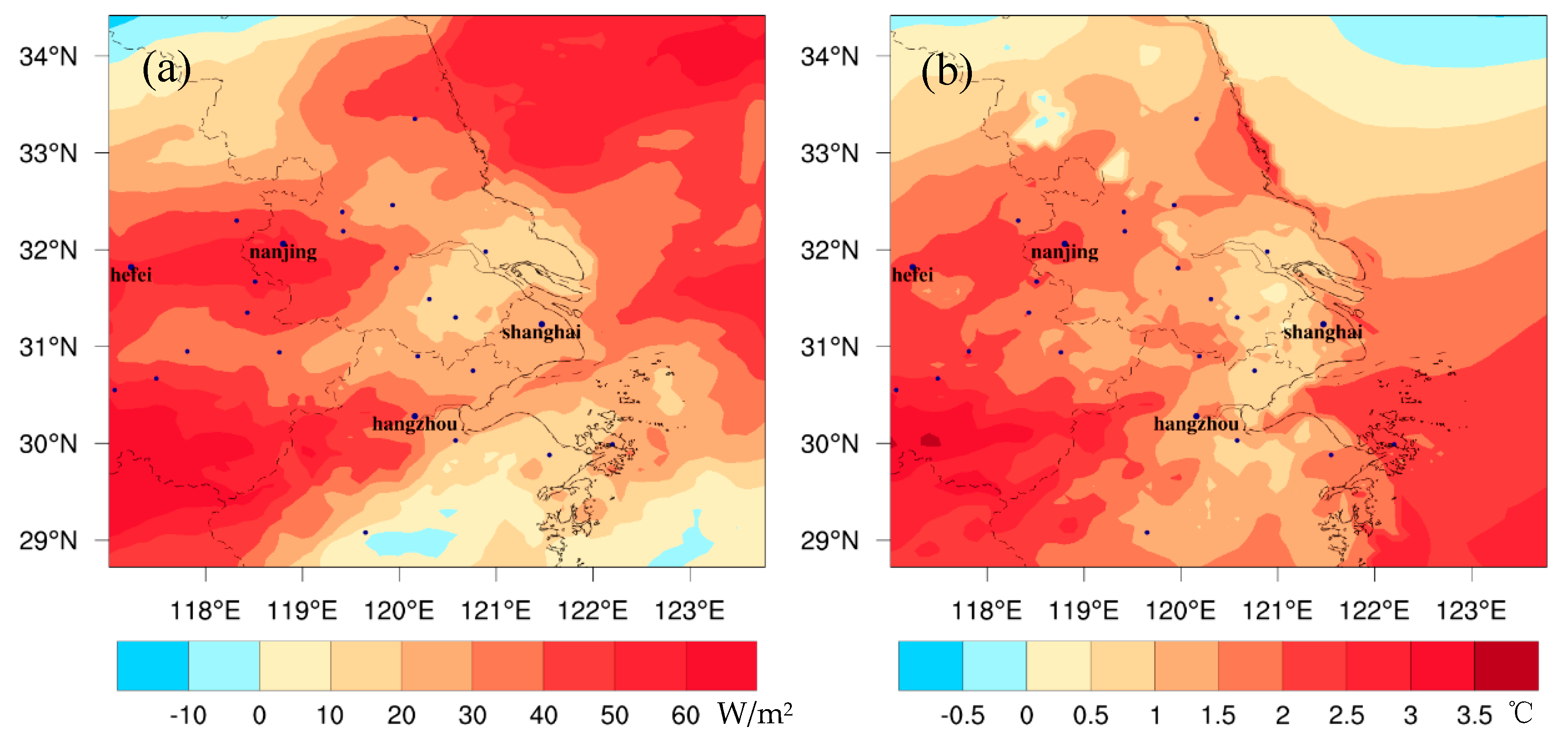
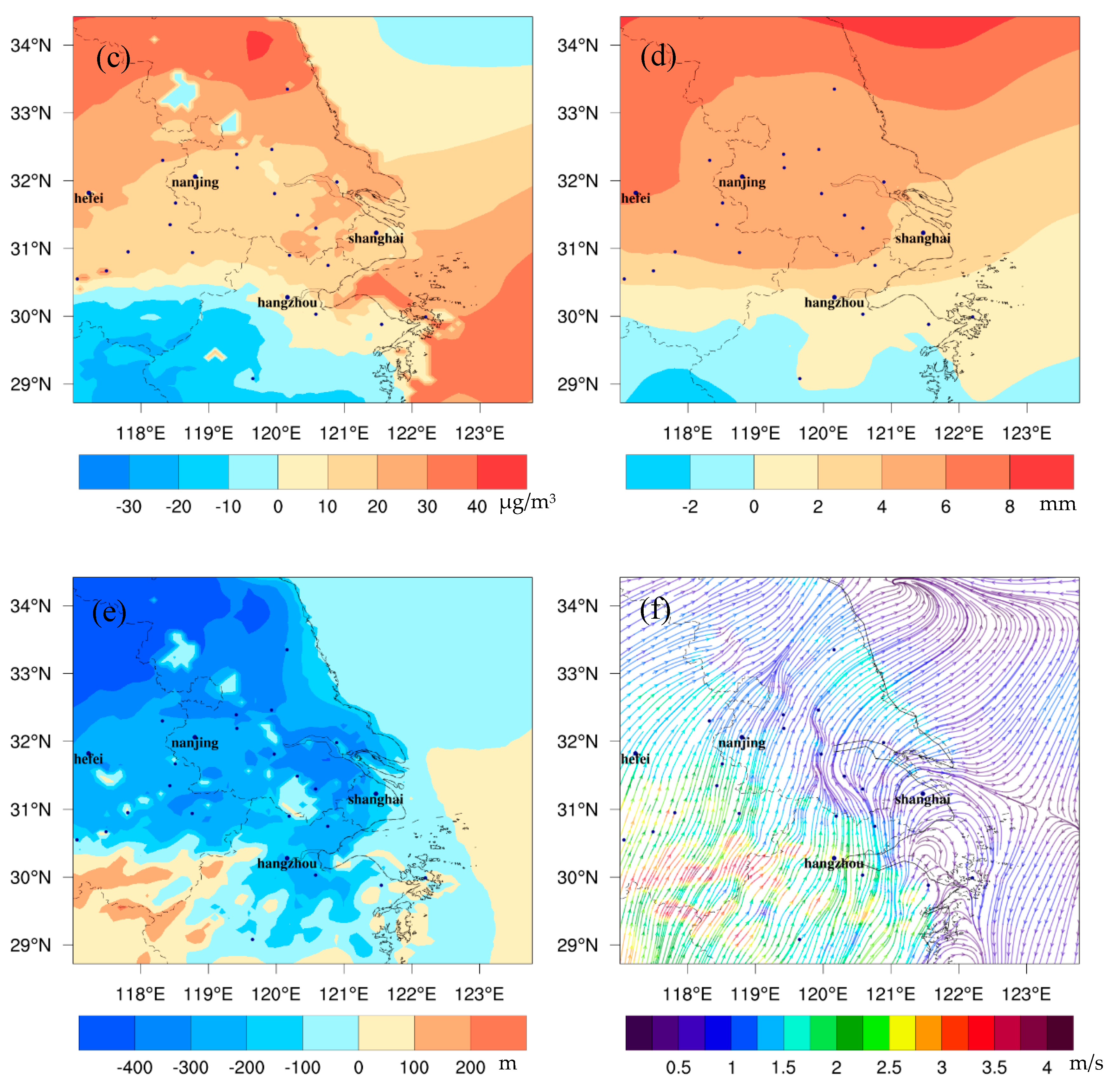
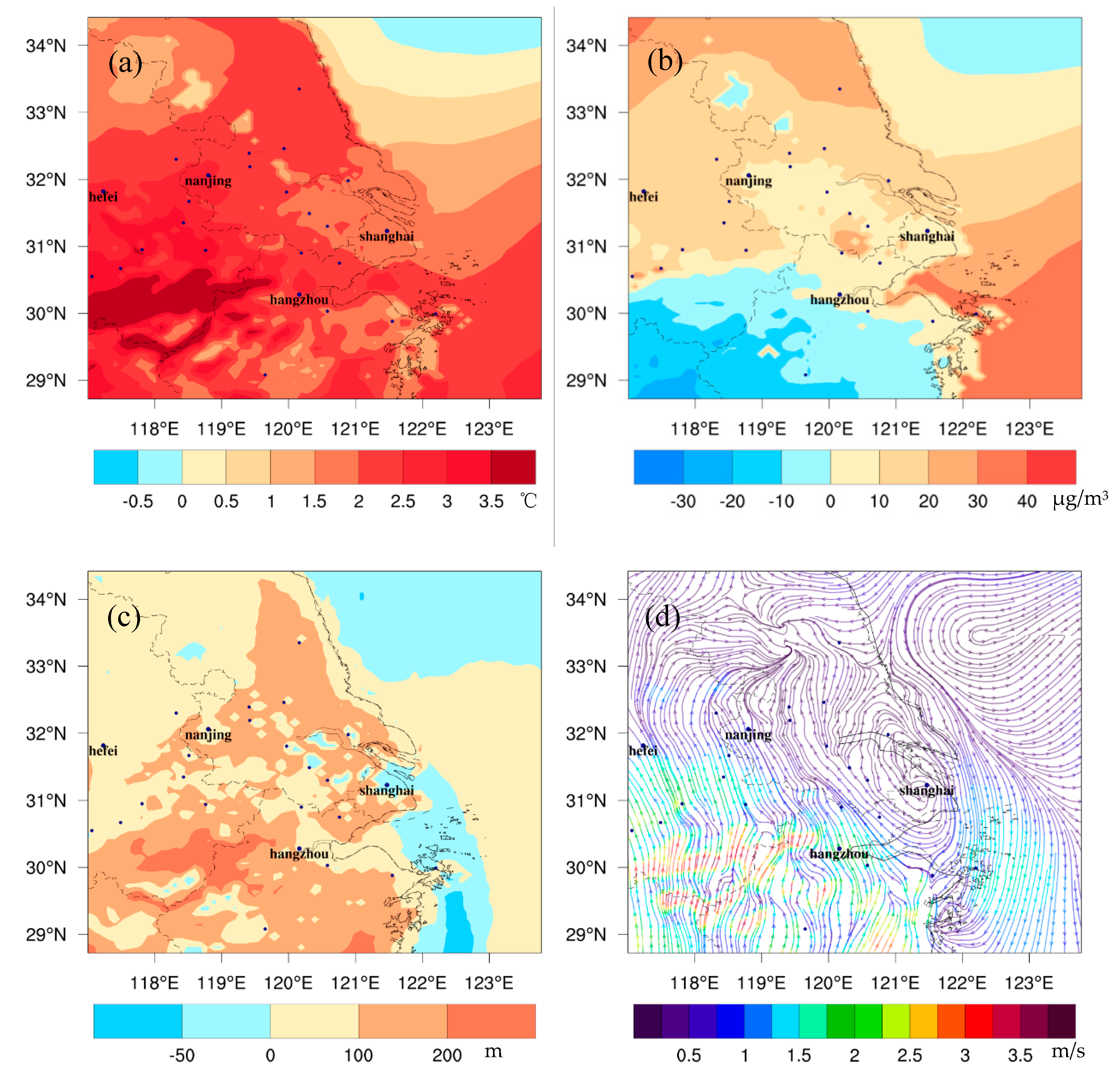
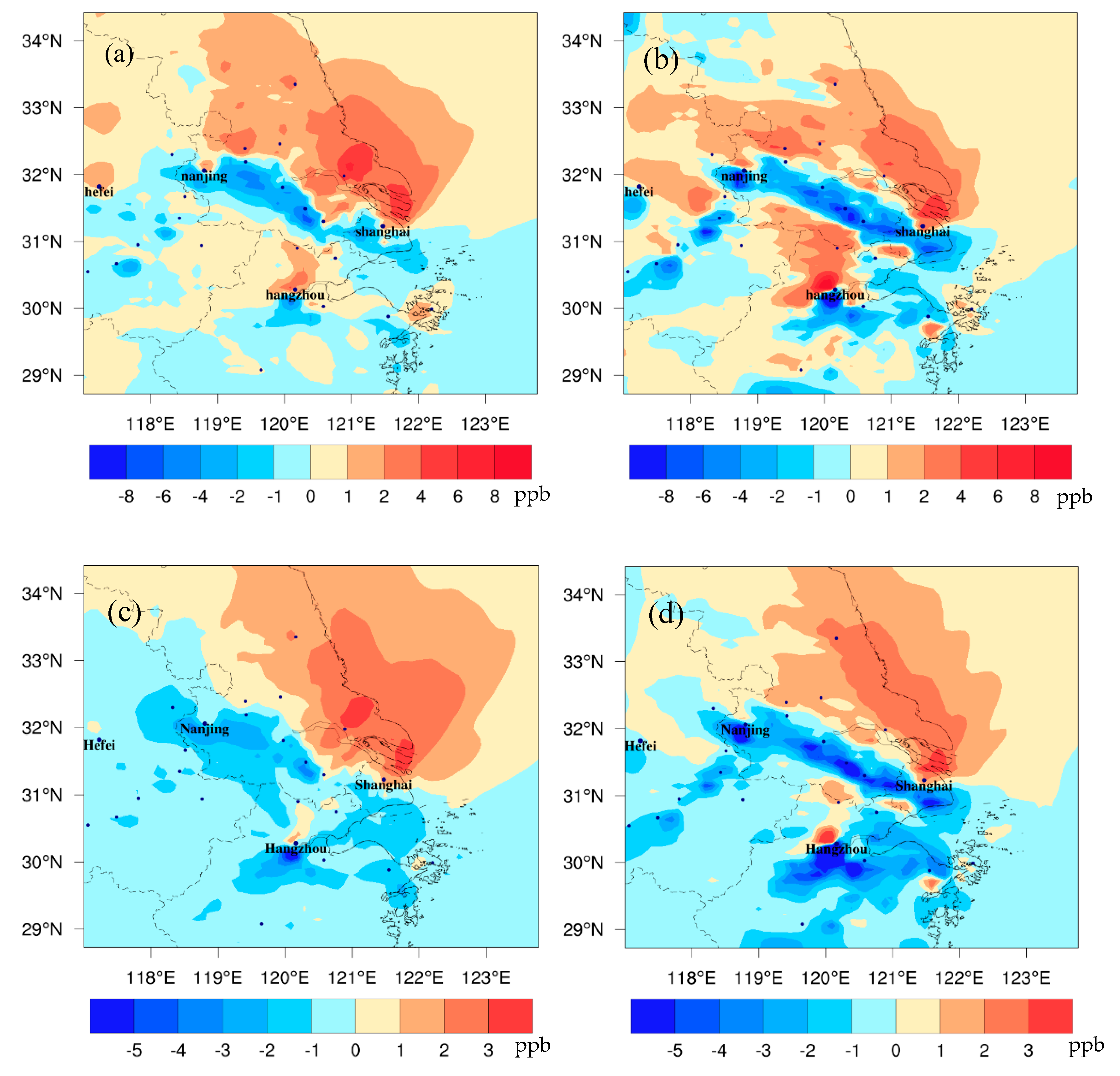
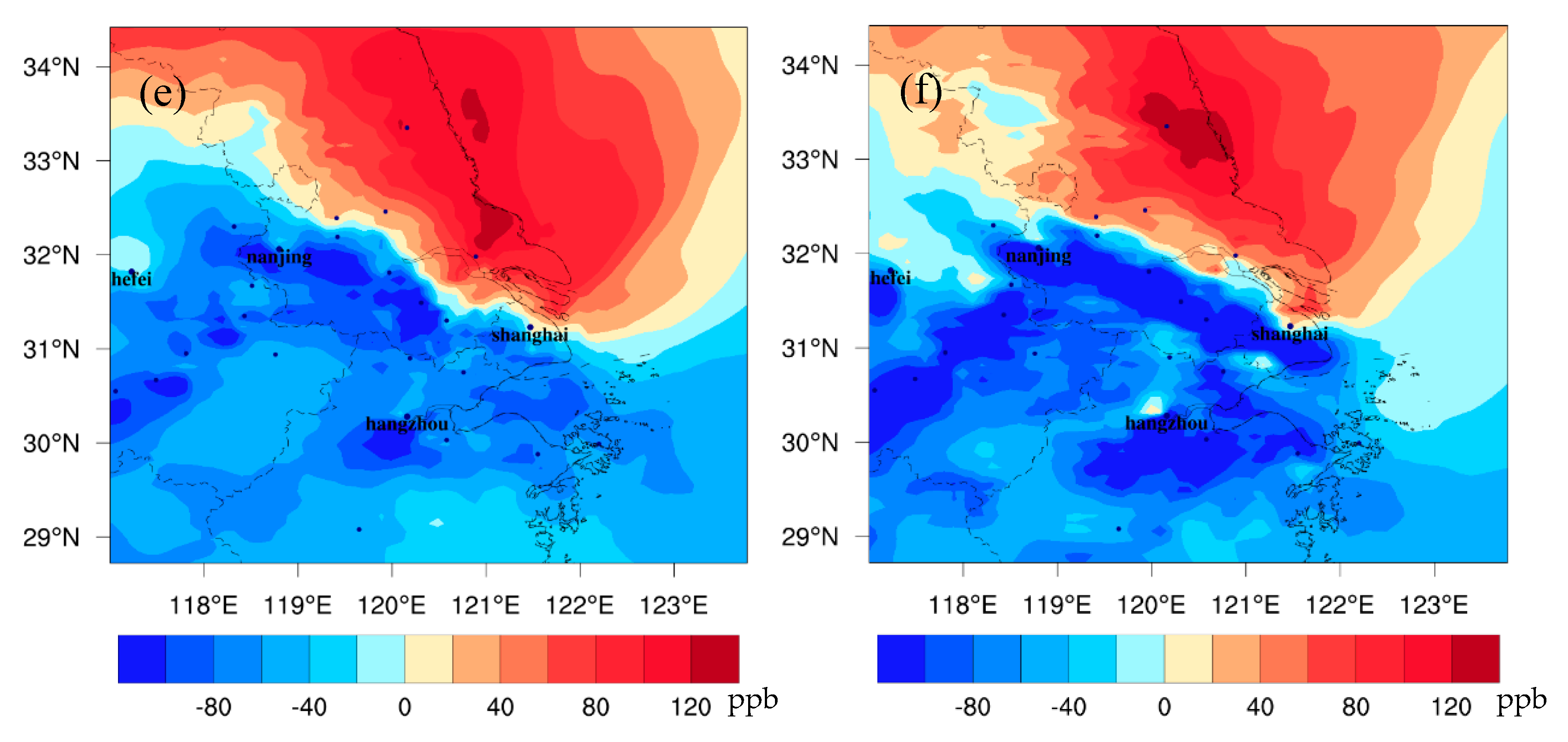
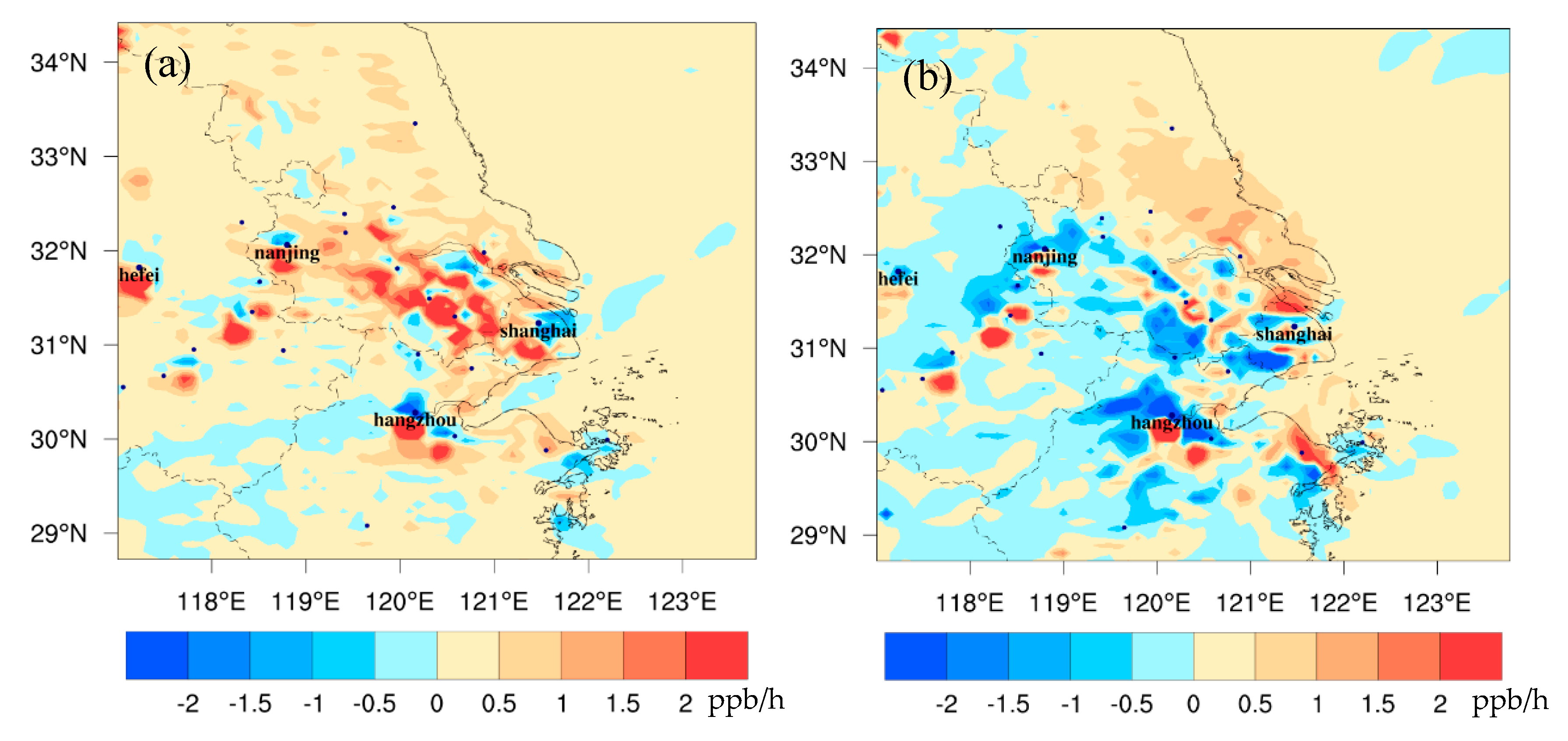
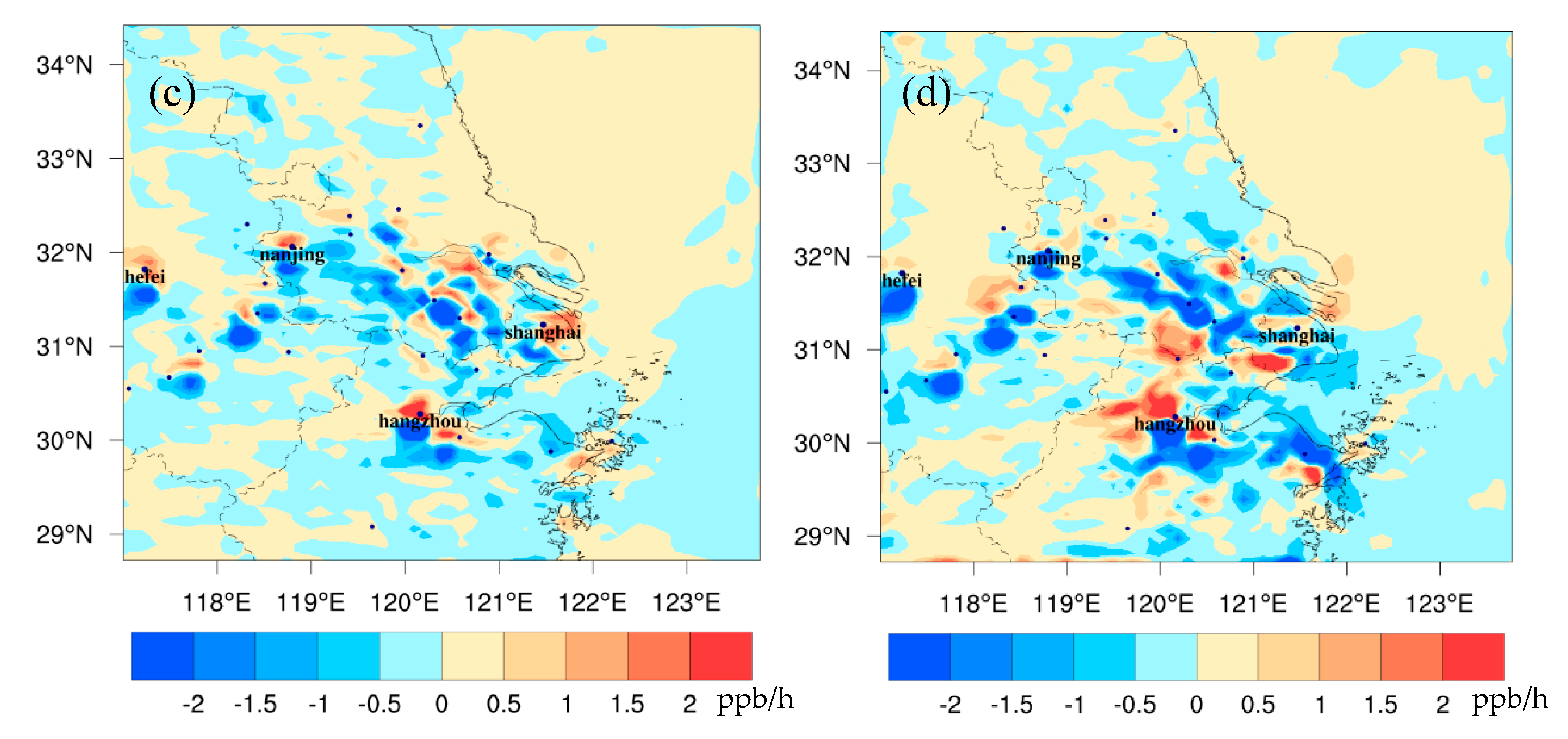
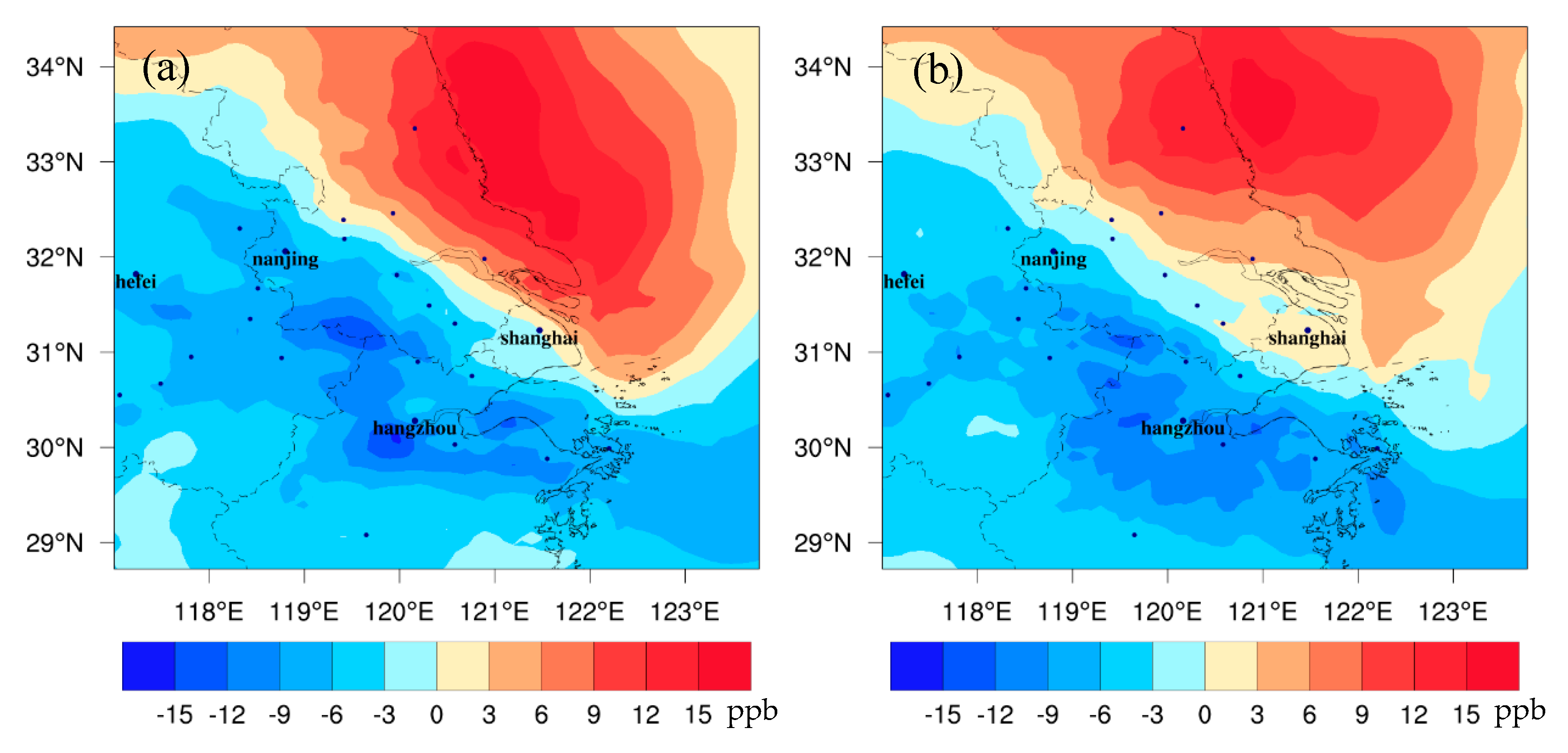
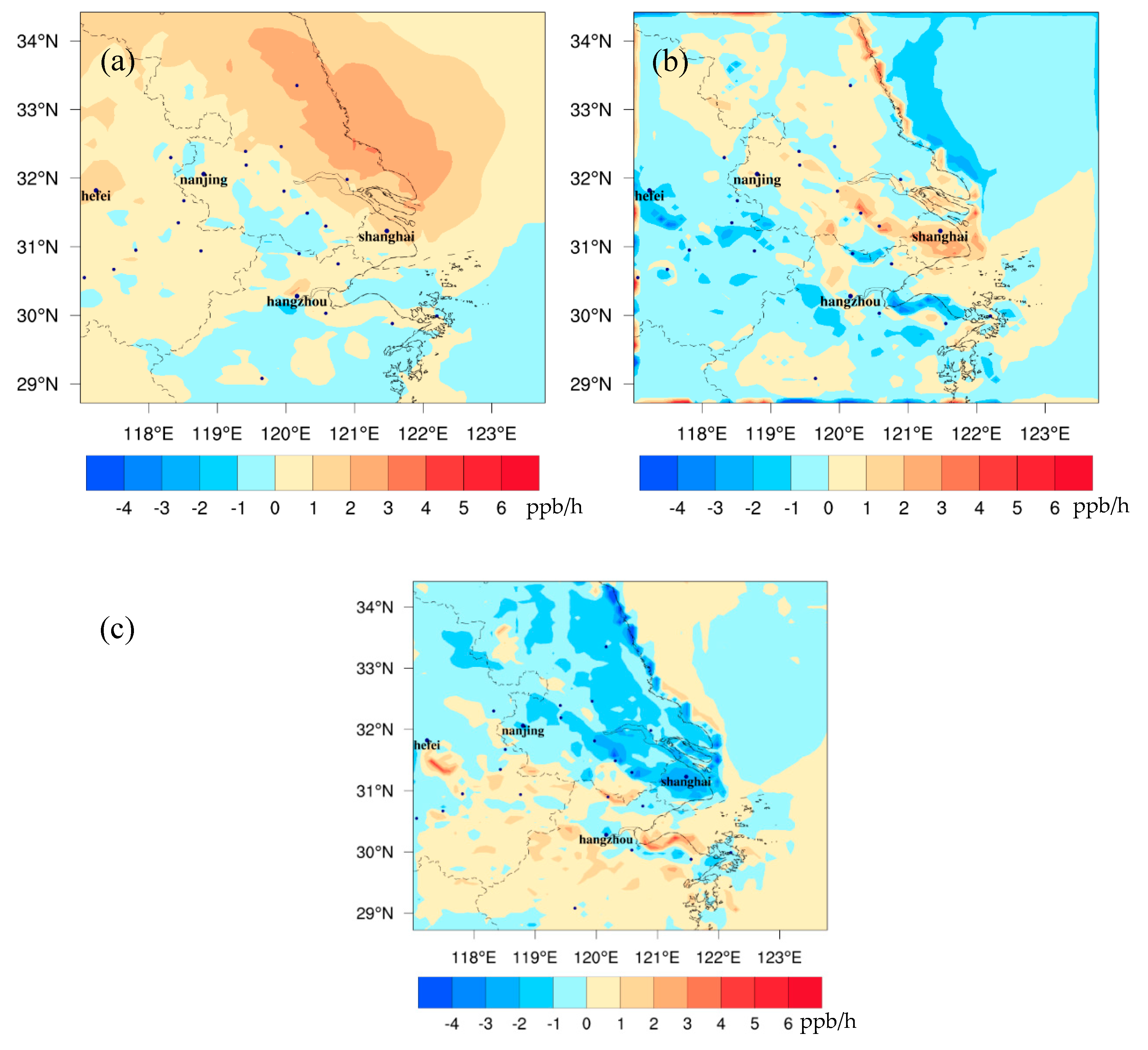
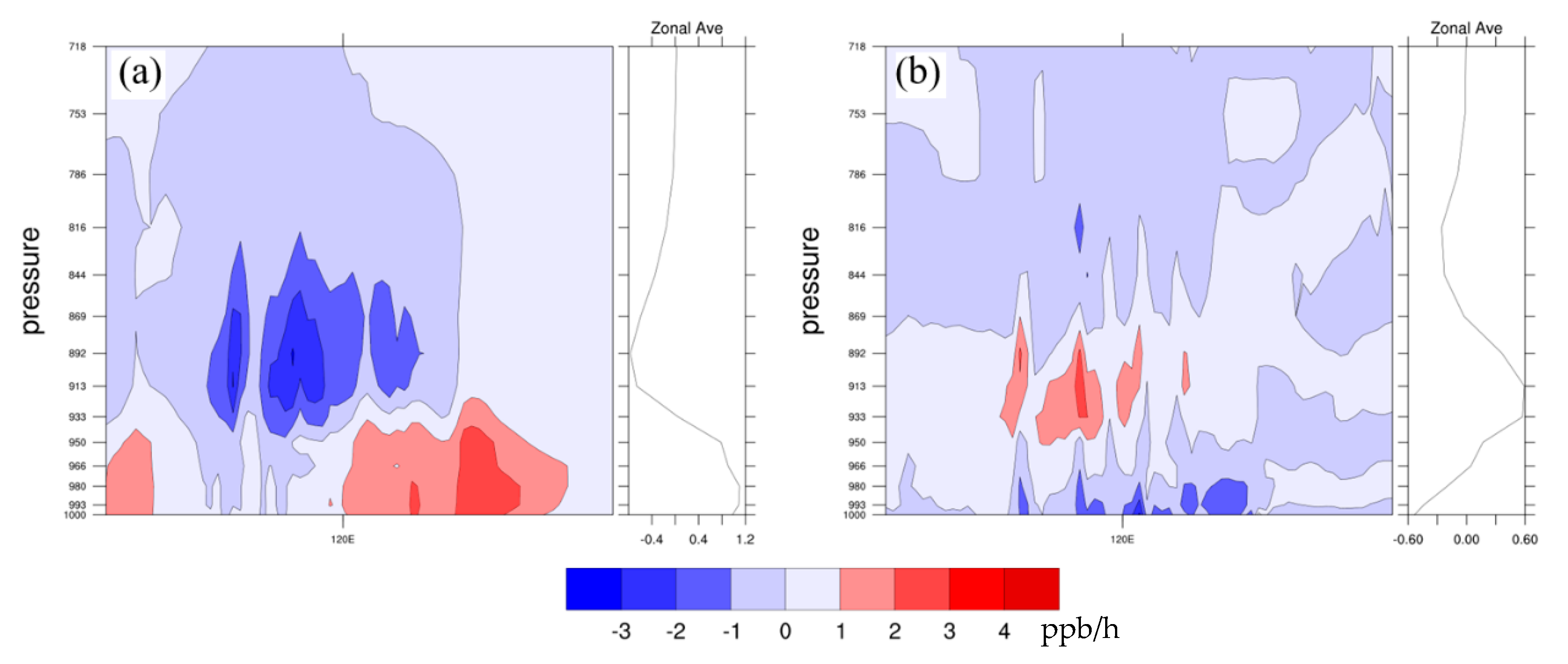
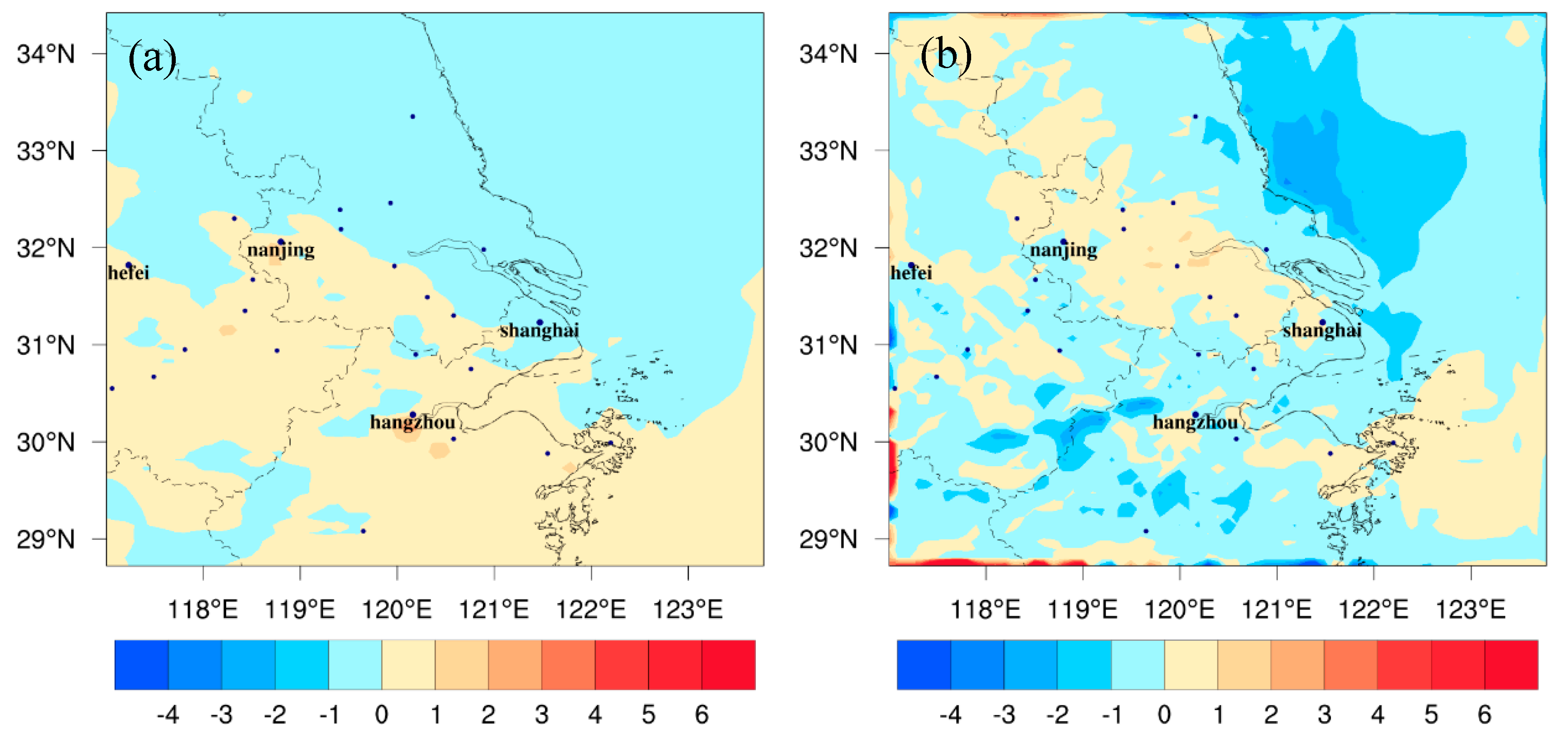
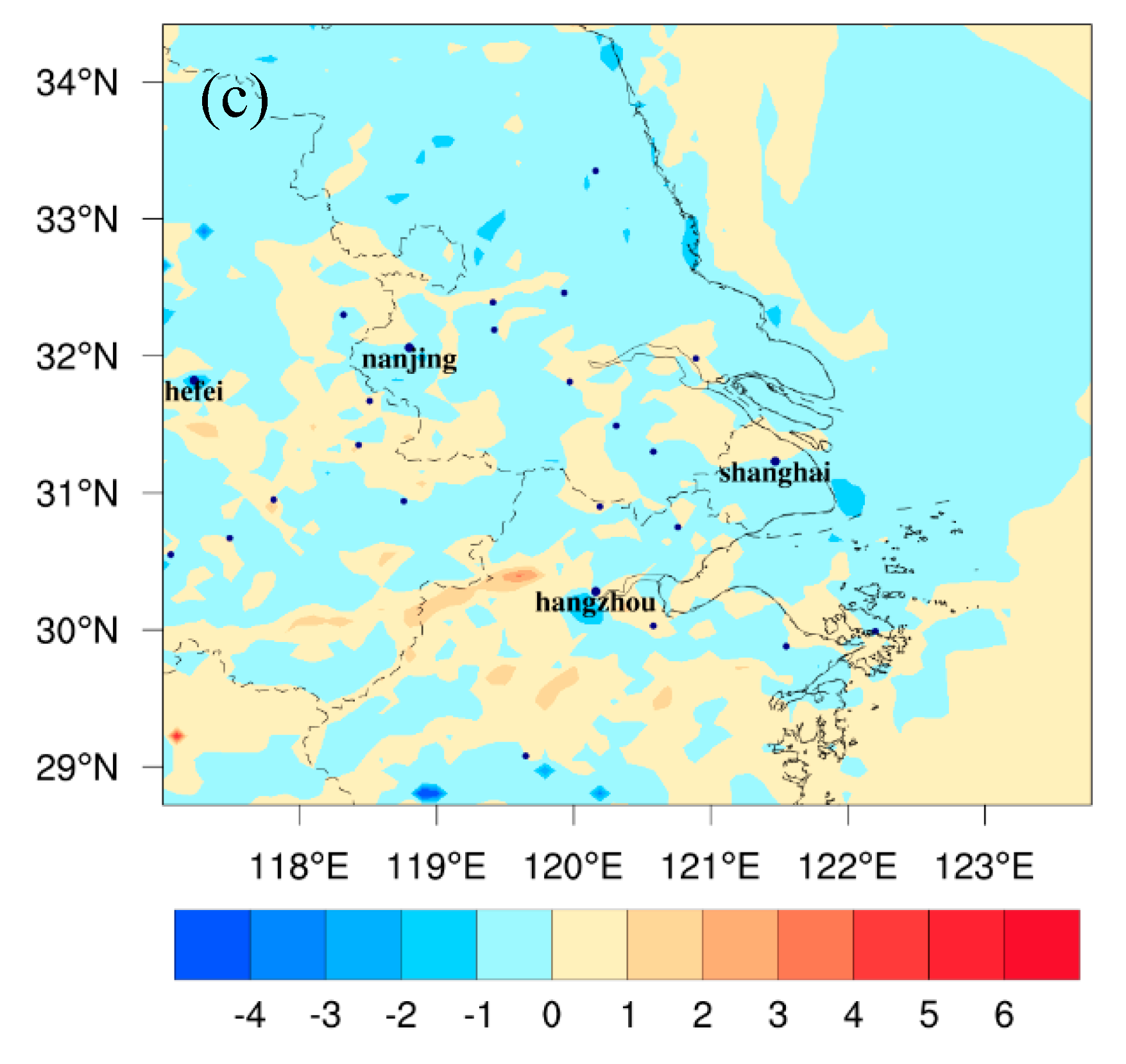
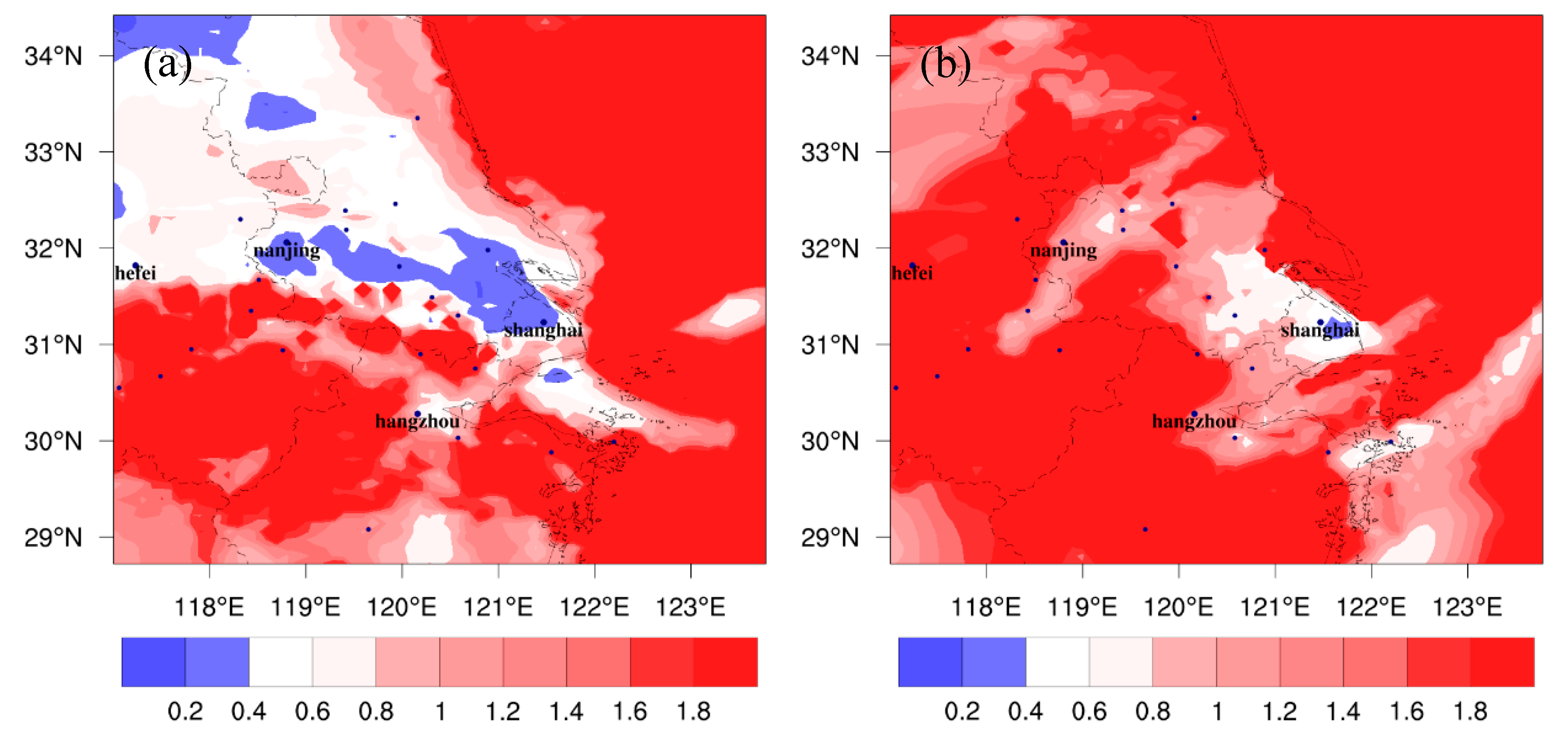
| Items | Contents |
|---|---|
| Dimensions (x, y) | (85, 750), (76, 70), (76, 70) |
| Grid size (km) | 81, 27, 9 |
| Time step (s) | 360 |
| Microphysics | Purdue Lin microphysics scheme |
| Long wave radiation | Rapid Radiative Transfer Model (RRTM) scheme |
| Shortwave radiation | Goddard scheme |
| Cumulus parameterization | Kain–Fritsch scheme, only for D01 and D02 |
| Land surface | NOAH land surface model |
| Planetary boundary layer | Mellor–Yamada–Janjic scheme |
| Gaseous chemical mechanism | Carbon-Bond Mechanism version Z (CBMZ) |
| Aerosol module | Model for Simulating Aerosol Interactions and Chemistry (MOSAIC) using 8 sectional aerosol bins |
| Vars | Sites | OBS | SIM | MB | RMSE | CORR |
|---|---|---|---|---|---|---|
| T2 (°C) | NJ | 26.9 | 27.4 | 0.5 | 3.9 | 0.9 |
| HZ | 28.2 | 30.0 | 1.7 | 3.4 | 0.9 | |
| SH | 27.6 | 28.5 | 0.8 | 2.8 | 0.8 | |
| RH2 (%) | NJ | 82.4 | 81.5 | −0.9 | 14.0 | 0.9 |
| HZ | 76.9 | 72.0 | −4.9 | 13.3 | 0.8 | |
| SH | 78.7 | 75.2 | −3.5 | 11.0 | 0.7 | |
| WS10 (m/s) | NJ | 2.3 | 2.0 | −0.2 | 1.2 | 0.6 |
| HZ | 2.0 | 2.0 | 0.1 | 1.1 | 0.5 | |
| SH | 1.1 | 3.5 | 2.5 | 1.8 | 0.4 | |
| O3 (ppb) | NJ | 35.9 | 43.5 | 7.6 | 23.0 | 0.6 |
| HZ | 35.6 | 43.5 | 7.9 | 23.6 | 0.6 | |
| SH | 33.5 | 32.3 | −1.2 | 32.2 | 0.7 |
© 2019 by the authors. Licensee MDPI, Basel, Switzerland. This article is an open access article distributed under the terms and conditions of the Creative Commons Attribution (CC BY) license (http://creativecommons.org/licenses/by/4.0/).
Share and Cite
Gao, D.; Xie, M.; Chen, X.; Wang, T.; Zhan, C.; Ren, J.; Liu, Q. Modeling the Effects of Climate Change on Surface Ozone during Summer in the Yangtze River Delta Region, China. Int. J. Environ. Res. Public Health 2019, 16, 1528. https://doi.org/10.3390/ijerph16091528
Gao D, Xie M, Chen X, Wang T, Zhan C, Ren J, Liu Q. Modeling the Effects of Climate Change on Surface Ozone during Summer in the Yangtze River Delta Region, China. International Journal of Environmental Research and Public Health. 2019; 16(9):1528. https://doi.org/10.3390/ijerph16091528
Chicago/Turabian StyleGao, Da, Min Xie, Xing Chen, Tijian Wang, Chenchao Zhan, Junyu Ren, and Qian Liu. 2019. "Modeling the Effects of Climate Change on Surface Ozone during Summer in the Yangtze River Delta Region, China" International Journal of Environmental Research and Public Health 16, no. 9: 1528. https://doi.org/10.3390/ijerph16091528
APA StyleGao, D., Xie, M., Chen, X., Wang, T., Zhan, C., Ren, J., & Liu, Q. (2019). Modeling the Effects of Climate Change on Surface Ozone during Summer in the Yangtze River Delta Region, China. International Journal of Environmental Research and Public Health, 16(9), 1528. https://doi.org/10.3390/ijerph16091528




